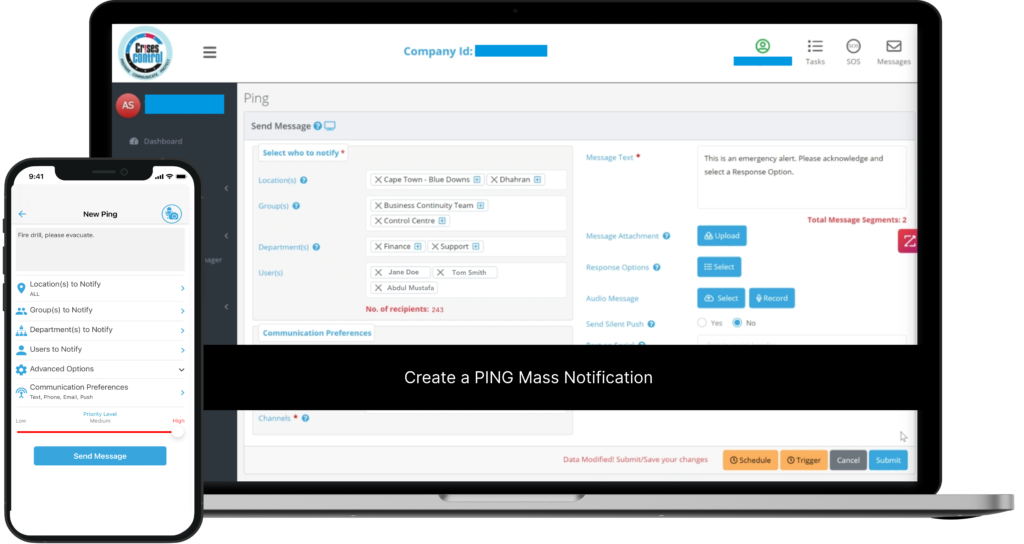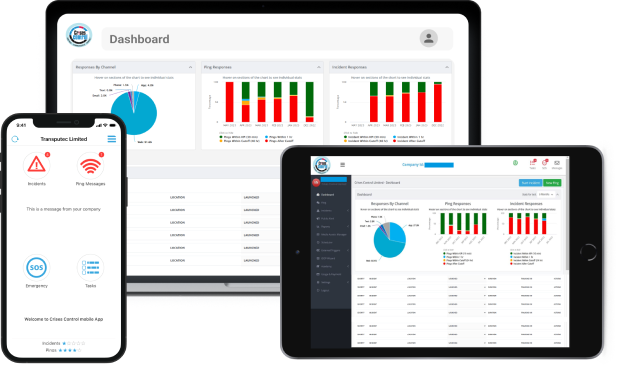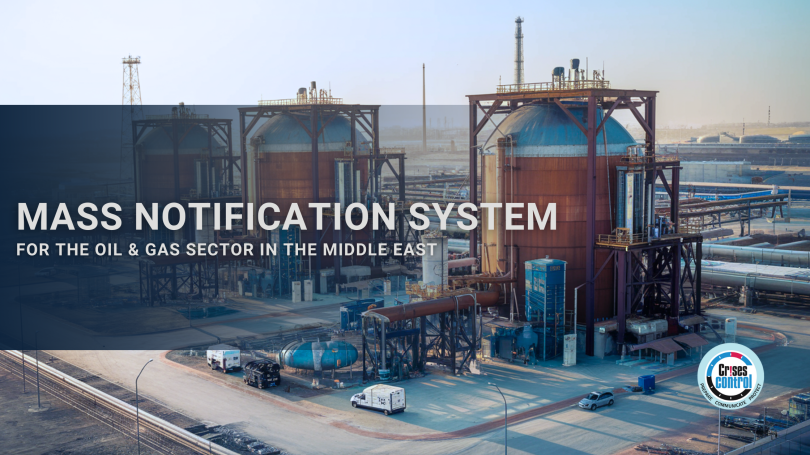Written by Anneri Fourie | Marketing Executive
The Importance of Safety in the Oil and Gas Sector
Safety is the bedrock of operations in the oil and gas industry. In an environment where large teams work with complex machinery, hazardous materials, and unpredictable conditions, a single mistake can result in severe consequences. The Middle East, known for its vast oil and gas reserves, poses unique challenges, from harsh environmental conditions to remote work locations.
As the industry evolves, so too must the ways we protect those who work within it. With growing concerns around operational efficiency, effective communication, and real-time response during crises, Mass Notification Systems are stepping up as a crucial tool for enhancing safety.
In this blog, we will explore how Mass Notification Systems are revolutionising safety operations in the Middle East’s oil and gas sector, and how Crises Control is leading this transformation. If you are responsible for managing teams, assets, or operations, read on to understand how you can protect your workforce and mitigate risks more effectively.
The Unique Safety Challenges in the Oil and Gas Industry
The oil and gas sector is inherently risky. Whether it’s offshore drilling, pipeline maintenance, or managing large teams across remote locations, the challenges are complex. The Middle East’s extreme climates, coupled with the vast geographical spread of operations, make traditional communication methods ineffective in emergencies. Here are some of the core challenges the industry faces:
Harsh Environmental Conditions
Oil and gas operations often take place in remote areas, where extreme temperatures, dust storms, or poor visibility can make communication difficult. Even when teams are in contact, the risk of information delays could make the difference between averting or escalating a crisis.
Large, Dispersed Teams
In the Middle East, oil and gas operations span vast territories, from offshore platforms to sprawling desert sites. Workers are often miles apart, making it hard to ensure that everyone gets the information they need in a timely manner.
Complex Operations
With many moving parts – drilling rigs, transportation networks, and supply chains – any failure, big or small, can trigger a cascade of problems. Coordinating responses during such moments requires immediate, clear communication.
These factors make having a communication system that can instantly reach every team member vital. This is where Mass Notification Systems become indispensable in managing risk.
How Mass Notification Systems Enhance Safety in Oil and Gas Operations
Mass Notification Systems are designed to tackle the most urgent communication challenges. Here’s how they can help revolutionise safety in your operations:
Real-Time Alerts: A Lifesaver in Emergencies
In the oil and gas industry, time is always of the essence. A gas leak, equipment failure, or fire requires an immediate response to prevent escalation. Mass Notification Systems enable companies to send out alerts across multiple channels (SMS, email, mobile apps, and automated voice messages) to ensure that every relevant individual gets the message without delay.
Crises Control’s Ping Mass Notification system sends real-time notifications to the right personnel, regardless of their location. Whether your teams are working on-site, offshore, or even between locations, they will receive real-time alerts with crucial information, enabling swift action.
Multichannel Communication: Ensuring Every Worker is Reached
One of the greatest advantages of Mass Notification Systems is the ability to use multiple communication channels to reach everyone. With workers often spread across vast distances, relying on one channel (e.g., email) can leave some workers in the dark during an emergency.
Crises Control’s system sends alerts via:
- SMS and Email Alerts: Instant, direct alerts sent to mobile phones and email addresses that your teams rely on.
- The Mobile App: Real-time updates on the go, ensuring workers who may be off-site or working in remote locations stay connected.
- Voice Messages: Automated voice calls to ensure that workers who may not have access to screens can still get the information they need.
- Social Media Integration: In some environments, workers may rely on social media channels for communication, and integrating these platforms ensures no one misses critical updates.
This multichannel approach ensures that even if one method fails, the message will still be delivered.
Automated Incident Management: Streamlining Crisis Response
In high-stakes environments like oil and gas, it’s not just about sending alerts—it’s about what happens next. Once a notification is issued, it’s vital that the right actions are taken without hesitation. Automated incident management allows you to manage and respond to emergencies quickly.
Crises Control integrates incident management directly with your Mass Notification System, enabling actions like:
- Assigning roles to team members based on their expertise and proximity to the emergency site.
- Notifying emergency responders immediately so that they can begin coordination efforts.
- Triggering automatic protocols such as evacuations, equipment shutdowns, or safety lockdowns, ensuring that responses are quick and consistent.
By automating these processes, you reduce the likelihood of errors, confusion, and delays during critical moments, all while ensuring that everyone knows what their role is and when to act.
Incident Tracking and Post-Incident Reporting: Learning from Every Crisis
Once the dust settles, it’s time to learn and improve. Incident tracking and reporting provide valuable insights into how your system performed during an emergency. With Crises Control, you get real-time data that can be used for:
- Monitoring updates to track how team members are responding in real time.
- Recording actions taken and decisions made during the incident, which helps in improving future responses.
- Post-crisis analysis to ensure compliance with local and international safety regulations, and to identify areas where you can improve crisis management protocols.
These capabilities help ensure that you don’t just react during an emergency—you prepare for the next one with better insight and improved processes.
Interested in our Ping Mass Notification System?
Efficiently alert everyone in seconds at scale with our Mass Notification System – PING, get the message out fast and ensure rapid response and recovery.

How Crises Control is Revolutionising Mass Notification in Oil and Gas
Crises Control is leading the charge in transforming safety for the oil and gas sector with its advanced Mass Notification System. Designed specifically for industries with high-risk environments, Crises Control offers features that are tailored to meet the unique needs of oil and gas operations. Here’s how we’re making a difference:
Crises Control Features for the Oil and Gas Sector:
- Ping Mass Notification: Send real-time alerts across SMS, email, mobile apps, and voice calls, ensuring that every worker, regardless of location, is informed immediately.
- Incident Management: Coordinate emergency responses seamlessly with built-in workflows, task assignments, and escalation protocols that trigger automatically for speed and accuracy.
- SOS Panic Button: Workers can activate an SOS alert through the Crises Control app, immediately notifying safety personnel and prompting swift action.
- Task Manager and Incident Plan Builder: Assign and track tasks during emergencies, ensuring that all necessary actions are executed without delay. Customise plans for various emergency scenarios to ensure readiness at all times.
- Cloud-Based Infrastructure: Operating on a secure, cloud-based platform, Crises Control ensures communication remains uninterrupted, even in the most remote regions with poor connectivity.
- Reporting and Audit: Keep detailed logs of every action taken during an incident. This helps with compliance, future training, and ongoing improvements in safety protocols.
The Future of Mass Notification in the Oil and Gas Sector
The future of mass notification in the oil and gas sector is bright, driven by technological advancements such as predictive analytics, IoT devices, and AI. These technologies will enable companies to foresee risks and proactively respond to potential threats before they escalate.
As oil and gas operations in the Middle East continue to expand, so will the need for reliable, intelligent communication systems. Mass Notification Systems will play an even greater role in ensuring the safety of workers, reducing downtime, and protecting the environment.
Conclusion: Take Action Today for Safer Operations
The oil and gas industry faces constant challenges, but with the right tools, you can ensure your team’s safety and operational efficiency. Mass Notification Systems are an essential component of modern safety strategies, providing the real-time communication needed during emergencies to prevent disasters.
If you’re looking for a way to improve your crisis management and alerting systems, Crises Control is here to help. Our platform is designed to streamline safety protocols, boost communication, and save lives in the oil and gas sector. Contact us today to see how Crises Control can revolutionise your approach to crisis management.
Request a FREE Demo








